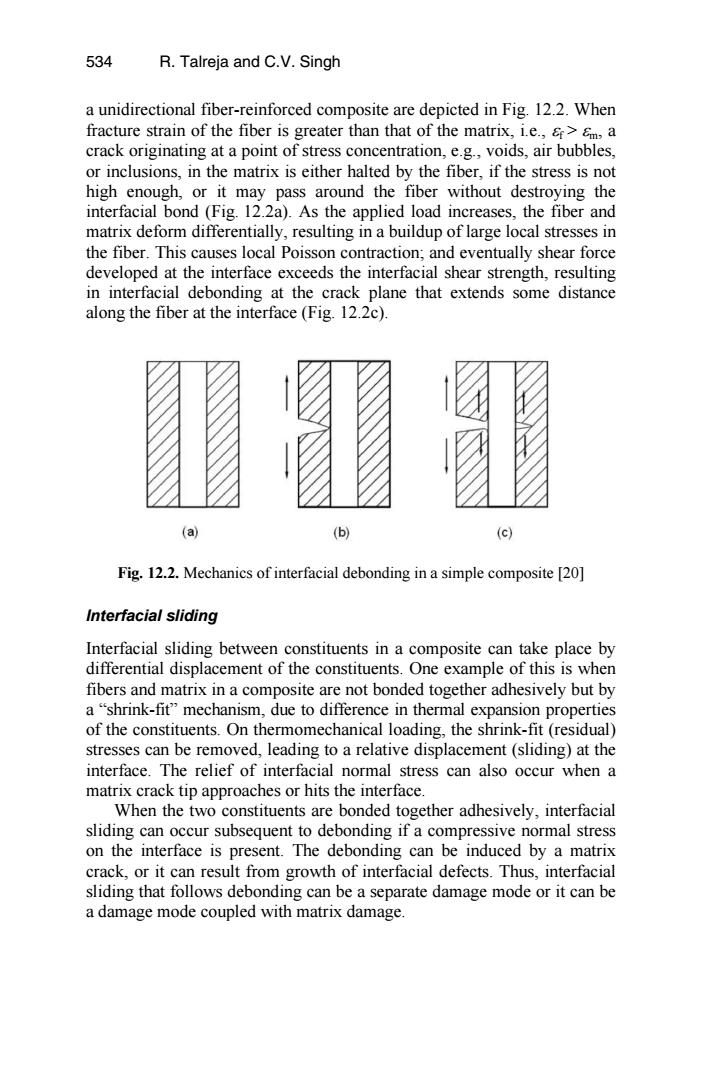正在加载图片...

534 R.Talreja and C.V.Singh a unidirectional fiber-reinforced composite are depicted in Fig.12.2.When fracture strain of the fiber is greater than that of the matrix,i.e.,r>&m,a crack originating at a point of stress concentration,e.g.,voids,air bubbles, or inclusions,in the matrix is either halted by the fiber,if the stress is not high enough,or it may pass around the fiber without destroying the interfacial bond(Fig.12.2a).As the applied load increases,the fiber and matrix deform differentially,resulting in a buildup of large local stresses in the fiber.This causes local Poisson contraction;and eventually shear force developed at the interface exceeds the interfacial shear strength,resulting in interfacial debonding at the crack plane that extends some distance along the fiber at the interface (Fig.12.2c). (a) (b) (c) Fig.12.2.Mechanics of interfacial debonding in a simple composite [20] Interfacial sliding Interfacial sliding between constituents in a composite can take place by differential displacement of the constituents.One example of this is when fibers and matrix in a composite are not bonded together adhesively but by a"shrink-fit"mechanism,due to difference in thermal expansion properties of the constituents.On thermomechanical loading,the shrink-fit (residual) stresses can be removed,leading to a relative displacement(sliding)at the interface.The relief of interfacial normal stress can also occur when a matrix crack tip approaches or hits the interface. When the two constituents are bonded together adhesively,interfacial sliding can occur subsequent to debonding if a compressive normal stress on the interface is present.The debonding can be induced by a matrix crack,or it can result from growth of interfacial defects.Thus,interfacial sliding that follows debonding can be a separate damage mode or it can be a damage mode coupled with matrix damage.a unidirectional fiber-reinforced composite are depicted in Fig. 12.2. When fracture strain of the fiber is greater than that of the matrix, i.e., εf > εm, a crack originating at a point of stress concentration, e.g., voids, air bubbles, or inclusions, in the matrix is either halted by the fiber, if the stress is not high enough, or it may pass around the fiber without destroying the interfacial bond (Fig. 12.2a). As the applied load increases, the fiber and matrix deform differentially, resulting in a buildup of large local stresses in the fiber. This causes local Poisson contraction; and eventually shear force developed at the interface exceeds the interfacial shear strength, resulting in interfacial debonding at the crack plane that extends some distance along the fiber at the interface (Fig. 12.2c). Fig. 12.2. Mechanics of interfacial debonding in a simple composite [20] Interfacial sliding Interfacial sliding between constituents in a composite can take place by differential displacement of the constituents. One example of this is when fibers and matrix in a composite are not bonded together adhesively but by a “shrink-fit” mechanism, due to difference in thermal expansion properties of the constituents. On thermomechanical loading, the shrink-fit (residual) stresses can be removed, leading to a relative displacement (sliding) at the interface. The relief of interfacial normal stress can also occur when a matrix crack tip approaches or hits the interface. When the two constituents are bonded together adhesively, interfacial sliding can occur subsequent to debonding if a compressive normal stress on the interface is present. The debonding can be induced by a matrix crack, or it can result from growth of interfacial defects. Thus, interfacial sliding that follows debonding can be a separate damage mode or it can be a damage mode coupled with matrix damage. 534 R. Talreja and C.V. Singh